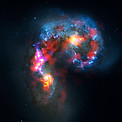
If there's one thing to be said for the Kepler mission, it's certainly turning up some very strange new worlds.

Humanity's most complex ground-based astronomy observatory, the Atacama Large Millimeter/submillimeter Array (ALMA), has officially opened for astronomers. The first released image, from a telescope still under construction, reveals a view of the Universe that cannot be seen at all by visible-light and infrared telescopes. Thousands of scientists from around the world have competed to be among the first few researchers to explore some of the darkest, coldest, furthest, and most hidden secrets of the cosmos with this new astronomical tool.

The Bolshoi supercomputer simulation, announced Thursday, is the most accurate and detailed large cosmological simulation run to date, giving physicists and

The "fifth planet" is a hypothesized giant world that was flung out of our solar system 4 billion years ago.

(PhysOrg.com) -- “We know that about 25% of the matter in the universe is dark matter, but we don’t know what it is,” Michael Kesden tells PhysOrg.com. “There are a number of different theories about what dark matter could be, but we think one alternative might be very small primordial black holes.”


To soar far away from Earth and even beyond the moon, NASA has dreamed up the world

Discovery News digs deep into our world's mysteries. Join us to explore current events and uncover the science behind the headlines. We Dig. You Discover.

Could our universe be located within the interior of a wormhole which itself is part of a black hole that lies within a much larger universe?

A new ground-based instrument will help astronomers using NASA

Sierra Nevada Corporation's (SNC) proposed Dream Chaser vehicle. It looks like a spacecraft ought to look. This is one of the key US commercial human spaceflight projects now in development.

A new era of utilization for research and technology begins for the completed International Space Station. The orbiting laboratory shifts focus in 2011 from finalizing construction efforts to full-scale use of the facility for scientific investigation and technological advances.

Astronomers using ESO’s world-leading exoplanet hunter HARPS have today announced a rich haul of more than 50 new exoplanets, including 16 super-Earths, one of which orbits at the edge of the habitable zone of its star. By studying the properties of all the HARPS planets found so far, the team has found that about 40% of stars similar to the Sun have at least one planet lighter than Saturn.

(PhysOrg.com) -- In the never ending search for proof that dark matter really exists, new findings have emerged from a team working under a big mountain in Italy. The group, from the Max Planck Institute in Germany, have pre-published a paper on arXiv, and have also given a talk at the Topics in Astroparticle and Underground Physics conference in Munich where they describe how their CRESST II detector has recorded 67 events which they say cannot be explained by anything other than Weakly Interacting Massive Particles (WIMPS), a type of dark matter.

The 1,800-acre Spaceport America site, in Las Cruces, New Mexico, is the home base for Virgin Galactic, Richard Branson